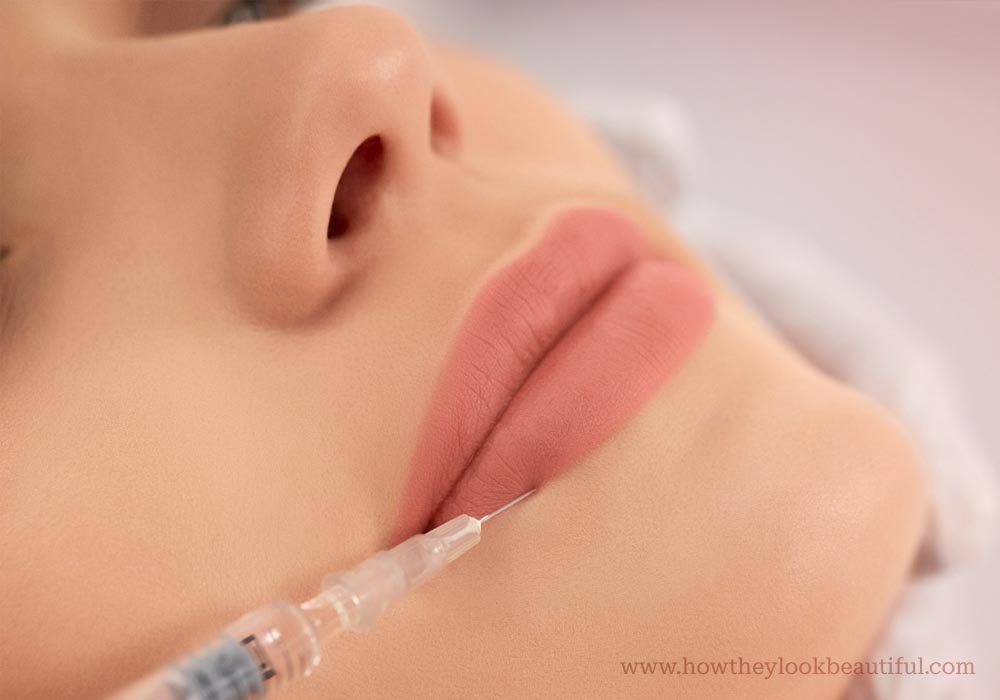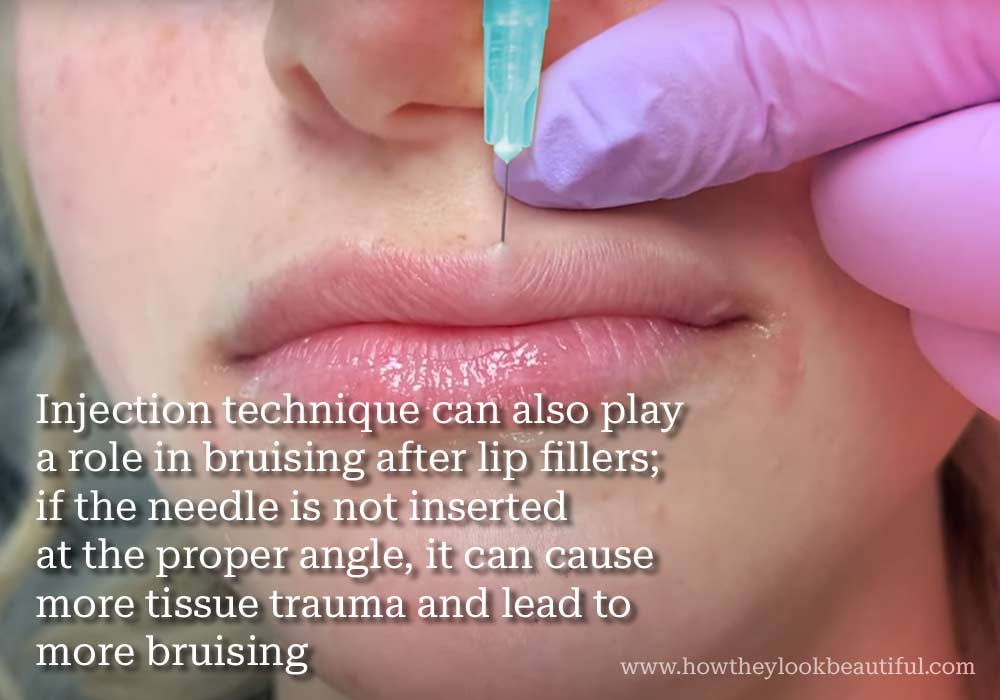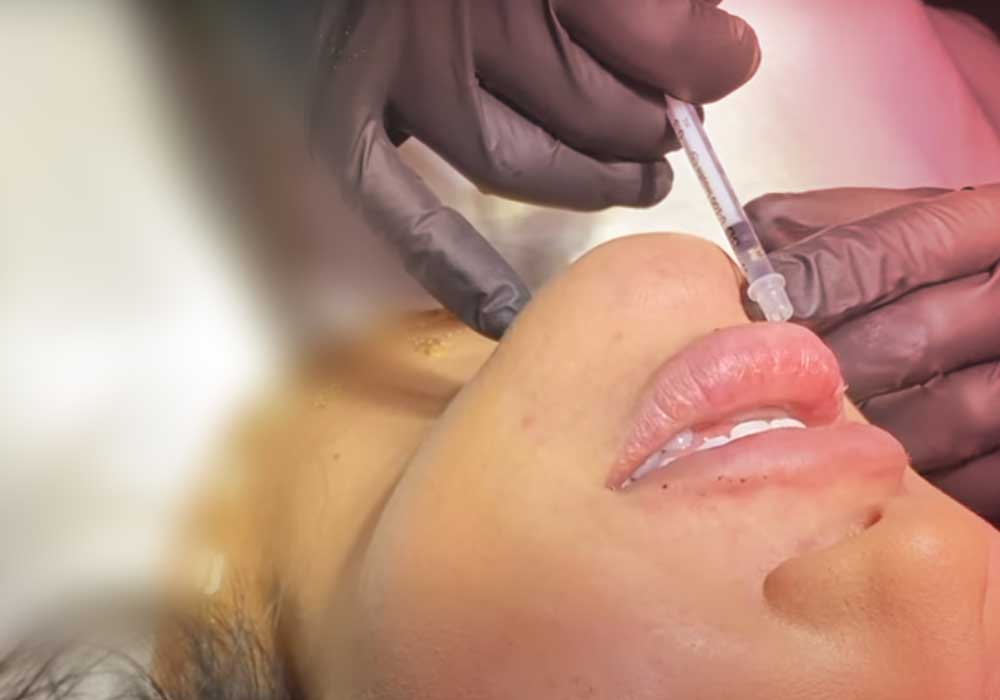Lip fillers are a popular cosmetic treatment that can give your lips a fuller, plumper look. But how long do the bruises last, and what are the risks associated with lip fillers? Read to know more.
Bruising & swelling are the most common side effects of lip fillers. Bruises usually last for about a week, but can occasionally take longer to heal. Swelling and redness can typically last for a few days.

- What are Lip Fillers?
- How do lip fillers work?
- Types of lip fillers
- Lip Filler Before After Photo
- Before Lip Filling…
- What is a Bruise?
- How Long do Bruises Last After Lip Fillers?
- What Causes Swelling and Bruising After Lip Fillers?
- Complications
- Can Lip Fillers Go Wrong?
- Recovery
- How to Reduce Bruising After Lip Fillers?
- How Much Lip Filler Should I Get in My Lips?
- The Risks of Injecting Too Much Hyaluronic Acid Lip Fillers
- How Often Do You Need to Touch-up Lip Fillers?
- Frequently Asked Questions
- Conclusion
What are Lip Fillers?
Lip fillers can be made from a variety of materials, including fat from your own body (fat grafting or fat transfer), synthetic materials, or hyaluronic acid. There are pros and cons to each type of filler, so be sure to discuss all your options with your doctor before making a decision.
The results of lip fillers typically last for several months, although this can vary depending on the type of filler used and your body’s natural metabolism. Lip fillers are generally considered to be safe, but as with any medical procedure, there is a risk of complications. Make sure you always have a detailed discussion of the risks and benefits of lip fillers with your doctor before you proceed.
How do lip fillers work?
Lip fillers are made from a substance called hyaluronic acid, which is found naturally in the body. It helps keep the skin hydrated and plump by attracting and trapping water molecules. When injected into the lips, it can add volume and hydration giving fuller look to the lips. The injection process usually takes less than 30 minutes and can be done in a doctor’s office or clinic.
The filler is injected into the border of the lip to give definition and shape. For other facial areas, the filler is injected into deeper layers of the skin to give volume and lift. Pain relief is available during treatment but some patients may experience mild discomfort during the procedure.

Types of lip fillers
Lip fillers or soft tissue fillers can be made from a variety of materials, each with its own advantages and disadvantages. The most common types are made from hyaluronic acid, collagen, or fat.
1. Hyaluronic Acid Lip Fillers
Hyaluronic Acid Lip Fillers are the most popular type. They are made from a substance that naturally occurs in the body and is found in fluids in the eyes and connective tissue and joints, so they are less likely to cause an allergic reaction. They also last 6-9 months before needing to be replaced. However, they can sometimes cause bruising or swelling at the injection site.
There are several reasons why people may choose hyaluronic acid for lip fillers, including its natural properties, its ability to add volume and plumpness, and its relatively short recovery time. It plays an important role to promote collagen production, which keeps skin firm and elastic. Because of this, hyaluronic acid fillers are popular for facial contouring procedures.
2. Collagen lip fillers
Collagen lip fillers are another popular option. They provide a long-lasting result, often lasting up to 2 years. However, because they are made from animal protein, there is a small risk of allergic reaction. In addition, collagen lip fillers can sometimes cause lumps or bumps under the skin.
3. Calcium hydroxylapatite fillers
Calcium hydroxylapatite is a type of dermal filler used to treat wrinkles and other skin concerns. It is made from natural minerals found in our bones and teeth, making it a safe and effective option for many people. These fillers can be used to target specific areas of the face and can be used to help improve the overall appearance of the skin.
Calcium hydroxylapatite fillers have been shown to be safe and effective in many clinical studies. They are typically well-tolerated by patients with minimal side effects. It is ideal for use in all areas of the face but not indicated for lips augmentation, fine lines around the mouth, and under the eyes
Most calcium fillers last between six and twelve months. However, some people may experience longer-lasting results. touch-ups may be needed every few months to maintain results.
4. Laser lip treatment
Laser treatments have become a popular way to achieve fuller lips. Lasers can be used to target specific areas of the lips, such as the vermilion border, which is the line that separates the red part of the lip from the skin. By targeting this area, laser treatments can help to make the lips look fuller and more defined.
Laser treatments work by heating up the tissue in the targeted area. This helps to stimulate collagen production, which in turn can help to plump up the lips. Results typically last for 6 to 10 months, and there is no downtime required after the treatment.
Laser lip treatments are a relatively new option for people who want to improve the appearance of their lips.
Lip Filler Before After Photo

Before Lip Filling…
Before you take the plunge and schedule an appointment, there are a few things you should know.
For starters, it’s important to consult with a board-certified dermatologist or plastic surgeon who has experience performing lip filler injections. This will help ensure you receive the best possible results.
During your consultation, your doctor will assess your lips and facial structure to determine which type of filler would be best for you. They will also discuss the potential risks and side effects of the procedure. Ask your doctor to use a cannula instead of a needle for injection. It will considerably reduce the trauma caused by the needle.
Avoid aspirin and other blood-thinning medications for at least two weeks before your appointment. These medications can increase the risk of bruising and bleeding.
Be sure to ask any questions you have so that you feel fully informed before making a decision. Once you’ve decided that lip fillers are right for you, sit back and enjoy your new look!
What is a Bruise?
When you get lip fillers, the needles used can cause bruising. Bruising is when blood vessels are damaged and leak blood into your tissues. This can cause a black-and-blue or purple mark on your skin called a bruise.

How Long do Bruises Last After Lip Fillers?
Bruises are a common side effect after getting lip fillers. They usually last for about a week with no lasting effects but can take up to two weeks to completely go away. There are a few things you can do to help speed up the healing process, such as applying ice and taking Arnica homeopathic supplements for the first few days and avoiding strenuous activity. If you’re concerned about your bruises, be sure to contact your doctor.
What Causes Swelling and Bruising After Lip Fillers?
Swelling and bruising after lip fillers can occur for a variety of reasons. One common reason is that the needle used to inject the filler into the lips can damage small blood vessels, causing them to leak and resulting in bruising. Injection technique can also play a role; if the needle is not inserted at the proper angle, it can cause more tissue trauma and lead to more bruising. Additionally, both the type of filler used and the amount injected can affect bruising; certain types of fillers are more likely to cause bruising than others, and injecting too much filler at once can also increase the risk.
Also Read: Lip Fillers Before and After 1ml Hyaluronic Acid
Complications
When it comes to lip fillers, bruising is one of the most common side effects. While the bruising usually fades within a week or so, there are some rare cases where the bruising can last for much longer. In extreme cases, the bruising can even lead to permanent discoloration of the skin.
Another potential complication of lip fillers is infection. This is usually only a risk if the needles used to administer the filler are not sterile. Infection typically presents with symptoms like redness, swelling, and pain at the injection site. If you experience any of these symptoms after getting lip fillers, it’s important to see a doctor right away.
Finally, there is a small risk of allergic reaction to the lip filler material itself. Symptoms of an allergic reaction include itching, swelling, and difficulty breathing. These symptoms will typically disappear within two hours of the injection. However, if they don t go away or get worse, you may need emergency medical care.
Can Lip Fillers Go Wrong?
Like any other medical procedure, there are risks involved while lip filler procedures. Lip fillers can go wrong if they’re not appropriately injected, leading to serious side effects like infection, inflammation, and even paralysis. If not properly treated, an infection can lead to disfigurement. Another risk is that of the filler itself migrating away from the injection site. This can cause lumps and bumps under the skin, as well as pain and swelling. In rare cases, it can even lead to blindness.
If you’re considering lip fillers, it’s essential to do your research and choose a reputable doctor who has experience with this type of procedure. Don’t be afraid to ask questions about the risks and what you can expect afterward. Remember, your safety should always be your top priority.
Recovery
Most people experience some bruising after getting lip fillers, but the bruises usually go away within a week or two. Swelling will usually peak within 24 to 72 hours and then start to subside. To help with the healing process, you can apply ice to the area for 20 minutes at a time, take paracetamol if you’re in pain, and avoid strenuous activity for the first few days. Your doctor may also prescribe pain medication to help you get through the recovery period. Most people can go back to work or school the next day. It is possible that you will experience some swelling, bruising, and tenderness in your lips over the next few weeks.

How to Reduce Bruising After Lip Fillers?
While it’s normal to experience some bruising after getting lip fillers, there are a few things you can do to help reduce the appearance of purple bruises and speed up the healing process.
- Ask your doctor to use a cannula instead of a needle to inject the filler. A cannula is a blunt-tipped tube that minimizes trauma to the skin and tissue, which can help reduce bruising.
- Avoid rubbing or massaging the area.
- Avoid strenuous activity for 24-48 hours after the injection as this can increase swelling and bruising.
- Apply a cold compress or ice for 10-15 minutes immediately after treatment and several times a day thereafter. This will help minimize swelling and pain, and can also help reduce bruising.
- Avoid makeup or skincare products on the area for at least 24 hours after the injection.
- Arnica cream or gel is also known to be helpful in reducing bruising.
- Avoid using any heat on the area as this can increase swelling.
- Avoid alcohol, caffeine, and aspirin for a few days following your procedure.
How Much Lip Filler Should I Get in My Lips?
The amount of filler you need will depend on your desired look. If you want a subtle enhancement or natural look, then you may only need a small amount of filler like 0.5 ml or half syringe (milliliters or cc). But if you want fuller, more dramatic, more voluptuous lips, then you may need more filler – 1ml (1 syringe) or even more. Ultimately, it’s up to you and your doctor to decide how much filler is right for you.
There are a few things to keep in mind when deciding how much filler to get in your lips. First, consider the size of your lips. If you have naturally thin lips, you may need more filler to achieve your desired look. Second, think about the shape of your lips. If you want fuller, poutier lips, you’ll need more filler than someone who just wants to add a bit of volume. Finally, consider your budget.
The Risks of Injecting Too Much Hyaluronic Acid Lip Fillers
How much is too much?
While there is no medical definition for “too much” lip filler, there are certain risks associated with getting too much. These include pain, swelling, bruising, and infection. In rare cases, the filler can even cause the lips to rupture. You may end up with an uneven look, with some parts of your lips looking larger than others.
If you do decide to get lip filler, remember that less is often more. Start small and see how your body reacts before going back for more.
Injecting too much Hyaluronic Acid filler into the lips can cause a number of problems. The most common problem is that the lips can become swollen and painful. In some cases, the swelling can be so severe that it can cause the lips to crack and bleed. Injecting too much Hyaluronic Acid can also cause the skin around the lips to become thin and fragile. This can lead to bruising and scarring.
Tight clothing can cause friction against your skin, leading to ingrown hairs and irritation. Similarly, excessive sweating can lead to clogged pores, leading to the formation of ingrown hairs. Avoid wearing tight clothing immediately after shaving and opt for loose, breathable fabrics instead.
How Often Do You Need to Touch-up Lip Fillers?
Touch-ups for lip fillers are typically needed every 8 to 12 months, depending on the type of filler used and the individual’s natural metabolism. The body slowly breaks down and absorbs the filler over time.
For some people, they may find that they need to touch-up their lip fillers more frequently, while others may be able to go longer between touch-ups. It’s important to discuss your goals and expectations with your injector so that they can tailor a treatment plan that’s right for you.
This approach helps minimize the risk of complications, such as uneven lips or an over-inflated look. It also allows patients to gradually achieve their desired results.
Frequently Asked Questions
Dermal fillers are made from a variety of substances, including hyaluronic acid, collagen, and fat. They work by replenishing lost volume and filling in wrinkles from the inside out. Botox, on the other hand, is made from botulinum toxin. It works by temporarily paralyzing the muscles that cause wrinkles.
You may be able to get more lip injections as early as six weeks after your initial treatment.
Conclusion
Lip fillers are a popular cosmetic treatment to achieve fuller, more luscious lips. Swelling & bruising is one of the most common side effects of lip fillers. While the length of time a bruise lasts after receiving lip fillers can vary, the average is about a week. However, there are things that can be done to help speed up the healing process. Applying ice to the area for the first few days can help reduce swelling and inflammation. Keeping the area clean and avoiding makeup or other products that could irritate it is also important. Lip fillers can cause infections, swelling, bruising, and even permanent horrific disfigurement if they are not performed by a qualified professional. If you have any concerns about your bruise, be sure to consult with your doctor.
References:
- Soft-tissue Filler–associated Blindness: A Systematic Review of Case Reports and Case Series
- Calcium Hydroxylapatite
- Foreign body reaction to calcium hydroxylapatite after lip augmentation

Hi, I’m Annie,
What drives me is the ability to empower women by cultivating the self-confidence in their inner beauty, enhancing their self-image, and showing them that overall beauty needn’t be either difficult or costly and that they can seamlessly mould their style to suit their everyday needs, without having to make an either / or choice. I’m constantly surprised at every transformation and it drives me on to the next. My knowledge is enhanced by 18 years of hands-on experience, and learning from every new assignment.
When I’m not writing beauty advice for my blog, I’m consulting on make-up, hair, diet and style. Or I’m just kicking back my heels cuddling with my fat Lab, Coco.

